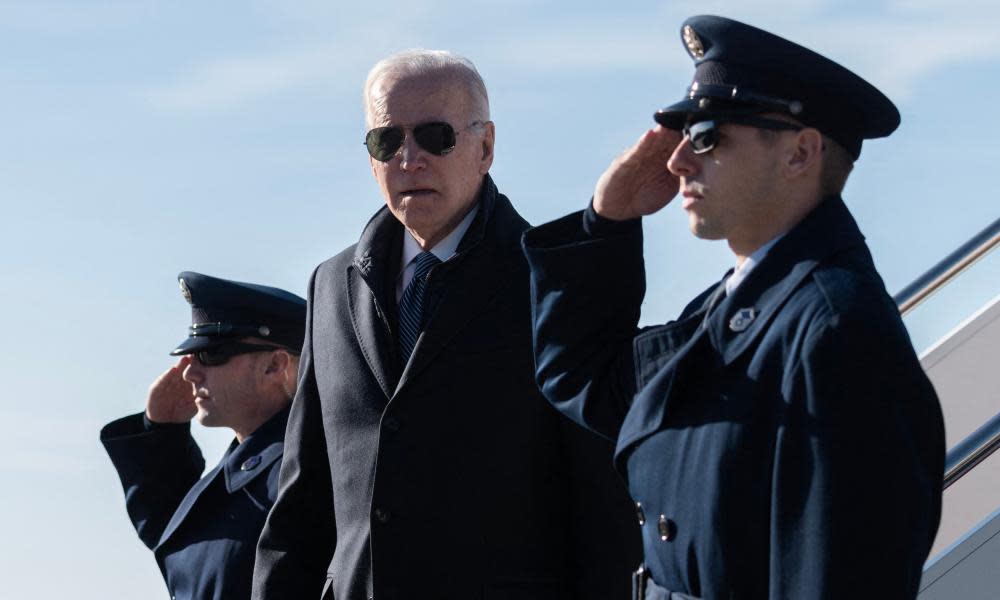The spy balloon saga says far more about Biden’s political weakness than China’s strength

The gigantic spy balloon that flew from China to the US lies punctured, shot down by an F-22 jet. Similarly in tatters is any optimism that Beijing and Washington might be able to salvage their relationship – and the alarming high stakes of global economic and geopolitical turmoil will be shared by the rest of the world, if their febrile bilateral tie is to unravel.
The incident left Chinese diplomats red-faced and US politicians fuming, and has led to a war of words across the Pacific, reports of previous sightings of Chinese balloons above US soil and the postponing of a highly anticipated visit to China by the US secretary of state, Antony Blinken.
The inflammatory response from both sides makes clear just how bad the relationship between the two nations has become. After all, as the US defence department has admitted, such balloons sent from China have actually appeared many times over the US in the past, without the breakdown in relations we’re seeing now. After five decades of rapprochement between the world’s two largest economies, China’s global influence has now grown to an extent that Washington feels increasingly unable to tolerate.
Beijing was, in fact, hoping to strengthen its ties with the US – after a chaotic exit from Covid lockdown and a strained relationship with the west in 2022, a diplomatic reset with the US and the EU would appear necessary if China is to tackle its domestic economic woes. China has traditionally relied on its relationships with the EU and the US to support innovation and growth – so a perceived isolation from the west is not an attractive option given President Xi’s hopes of economic recovery after China abandoned its much criticised zero-Covid policy.
However, this is easier said than done. There was little trust and warmth between the US and China even before the appearance of the balloon. The face-to-face meeting in November 2022 between Joe Biden and Xi Jinping was an attempt to prevent bilateral relations from going into freefall, but the balloon incident has inflamed tensions in both countries.
In Beijing, several hawkish opinion leaders proclaimed on Chinese social media that the US is in permanent decline and Washington would do whatever it could to contain China’s rise – hence China should take the opportunity to fight back with an iron fist.
Across the Pacific, Republicans have been busy establishing a new committee focused on competition between the US and China and the newly sworn-in Congress speaker, Kevin McCarthy, intends to follow in the footsteps of his predecessor in visiting Taiwan. Such a move will surely ruffle feathers in Beijing. The Biden administration cannot afford to look weak on China in the eyes of Republicans, nor can it, in this toxic political atmosphere, allow foreign forces entering its skies – a clear infringement of its airspace and potentially international law – to go unchallenged, as Biden set out in his State of the Union address.
The benefits of many fundamental elements of the US-China relationship, such as trade and investment, have been rapidly diminishing as a result of Chinese companies’ increasing commercial competitiveness and generous subsidies from Beijing. In military and technology terms, the two countries have become ultra-competitive, rather than needing to work together.
Two successive US administrations have waged a tech war against Beijing, believing that the US must have a technology monopoly in China despite its vastly different culture and political system. Innovation and technological prowess are at the core of Xi’s third term – a vision that assumes precarious bilateral relations with the US are here to stay. Accelerated domestic innovation is intended to reshape China’s industrial production and supply chains, which for now remain exposed to risks from overseas suppliers and vulnerable to shifting geopolitical trends.
The relationship between the countries has transitioned from the cooperation and relative stability of the early 2000s into one characterised by volatility and competition. Until Xi was faced with China’s post-pandemic economic challenge, the two countries simply hadn’t needed each other like they once did.
Meanwhile, other grievances have been mounting – from disputes over the truth of certain events, to blame over perceived wrongdoings, such as the origins of the Covid virus. Covid travel restrictions, Russia’s war on Ukraine and a lack of frequent face-to-face meetings between the two leaders have likely worsened matters.
It would be naive to assume that even before the balloon saga, Beijing and Washington could have eased tensions simply by a face-to-face meeting or a short visit by Blinken. However, Xi’s desire to create a stable external environment to allow for domestic economic development still offers an opportunity for diplomatic reconciliation with the US and the EU. Many existing beneficiaries of calmer bilateral ties, including major American business groups, are still eager to see relations take a positive turn. However, Biden might have little political space to allow diplomacy under pressure from a Republican-majority Congress, and may end up escalating the matter further.
The balloon saga is a sharp reminder that without effective communication, suspicion and tension can escalate quickly. It might be a cliche to call for calm and skilled diplomacy between Biden and Xi’s respective teams, but given the high stakes, neither Beijing nor Washington should become victims of a drifting balloon.
Dr Yu Jie is a senior research fellow on China in the Asia-Pacific Programme, Chatham House


